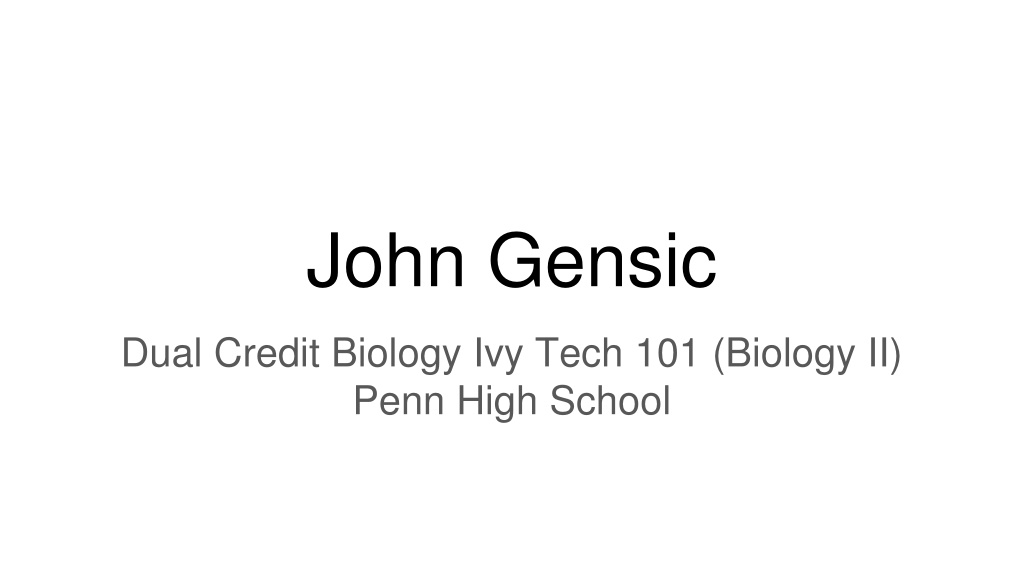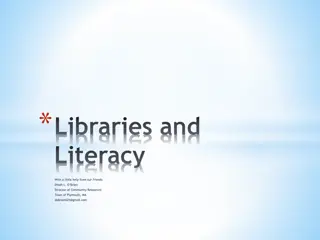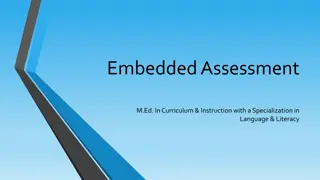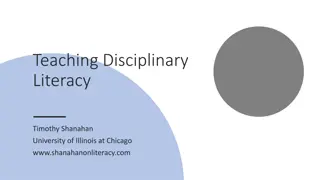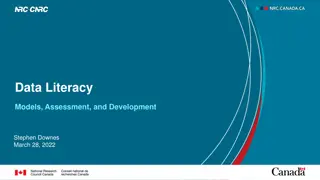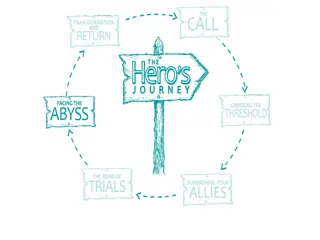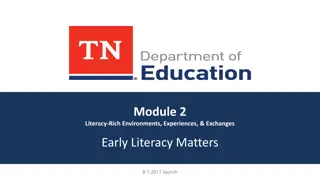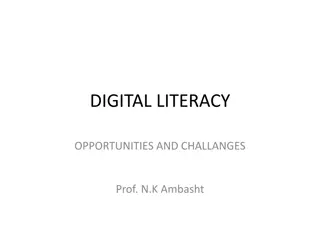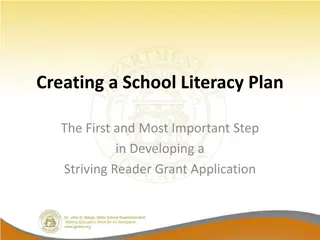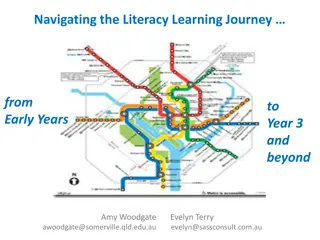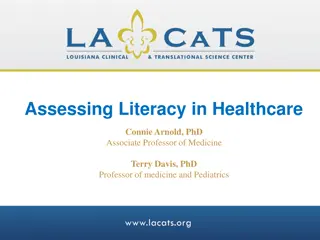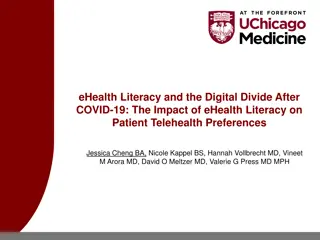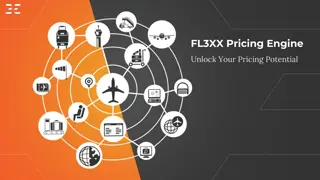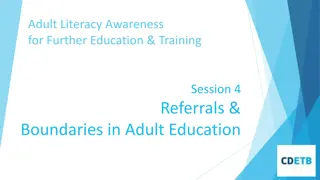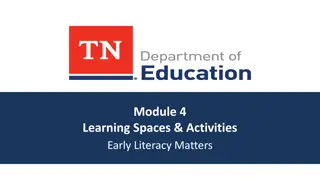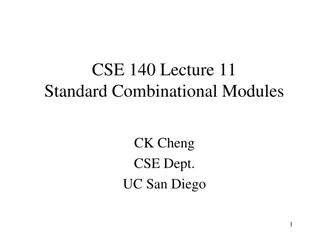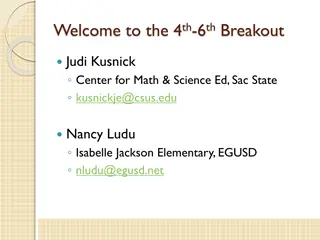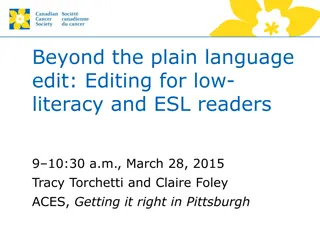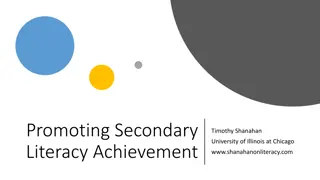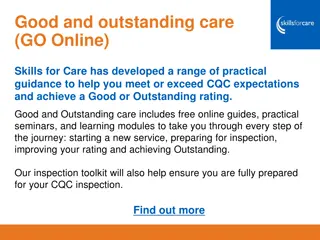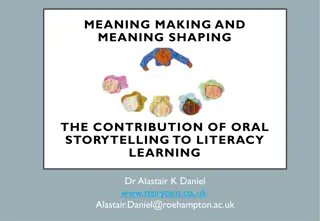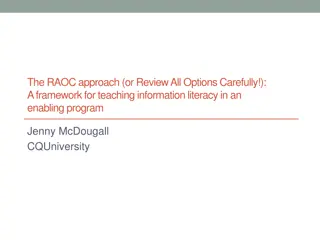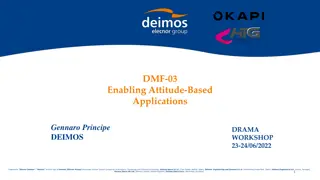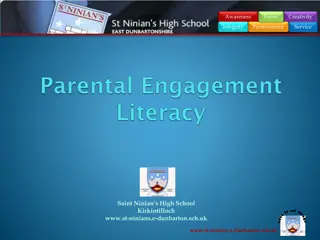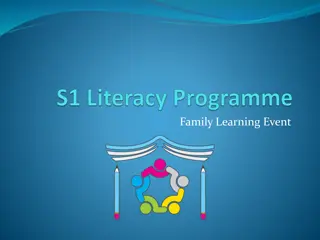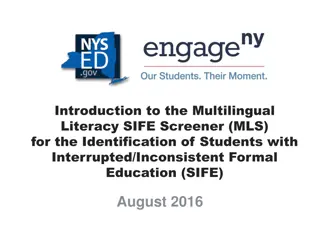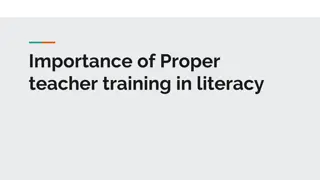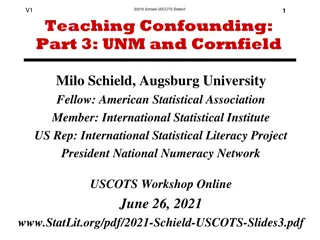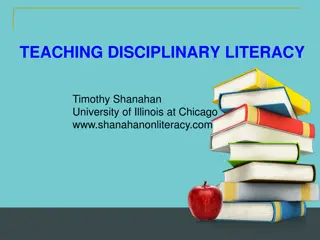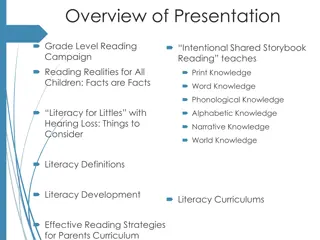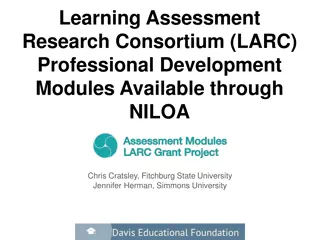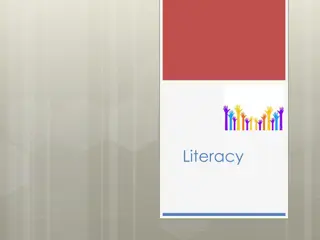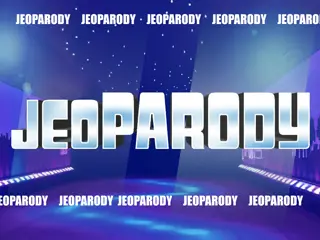Enhancing Data Literacy Through Engaging Modules and Lessons
In this content, John Gensic, a Dual Credit Biology student at Ivy Tech, and Penn High School, participates in modules aiming to explore and create data representations to support evidence-based claims. The overall goal is to foster critical thinking by evaluating various data sets and making evidence-based claims. Different lessons focus on selecting and evaluating data sets, creating data representations for experiments, and exploring topics like carbon emissions and efficiency. The content emphasizes engaging activities and resources, including watching Hans Rosling's insightful data presentations. Through these modules and lessons, students are encouraged to enhance their data literacy skills in an interactive and experiential manner.
Download Presentation

Please find below an Image/Link to download the presentation.
The content on the website is provided AS IS for your information and personal use only. It may not be sold, licensed, or shared on other websites without obtaining consent from the author. Download presentation by click this link. If you encounter any issues during the download, it is possible that the publisher has removed the file from their server.
E N D
Presentation Transcript
John Gensic Dual Credit Biology Ivy Tech 101 (Biology II) Penn High School
RET Module 2022 Overall Goal:explore and create interesting data representations to make and evaluate evidence based claims.
Module Progression Lesson A: SWBAT: select a data set, then evaluate and make evidence based claims. (Shreya s undergrads data representations) Lesson B: SWBAT: make and defend a data representation for an experiment they create to test artificial intelligence. (GPT3 experiments) Lesson C: SWBAT: evaluate carbon emission (and emission reduction) claims and evidence. Lesson C Part 2: SWBAT: design an experiment related to efficiency and carbon emissions. Potential electric bike experiment.
Lesson A: select a data set, then evaluate and make evidence based claims. Engage and Explore Hans Rosling's 200 Countries, 200 Years, 4 Minutes - The Joy of Stats - BBC Four Subscribe and Watch the BBC first on iPlayer Hans Rosling's famous lectures combine enormous quantities of public data with a sport's commentator's style to reveal the story of the world's past, present and future development. Now he explores stats in a way he has never done before - using augmented reality animation. In this spectacular section of 'The Joy of Stats' he tells the story of the world in 200 countries over 200 years using 120,000 numbers - in just four minutes. Plotting life expectancy against income for every country since 1810, Hans shows how the world we live in is radically different from the world most of us imagine. to the BBC https://bit.ly/BBCYouTubeSub https://bbc.in/iPlayer-Home More about this programme: http://www.bbc.co.uk/programmes/b00wgq0l ? ? ? Engage: Watch: Hans Rosling's 200 Countries, 200 Years, 4 Minutes - The Joy of Stats #bbc All our TV channels and S4C are available to watch live through BBC iPlayer, although some programmes may not be available to stream online due to rights. If you would like to read more on what types of programmes are available to watch live, check the 'Are all programmes that are broadcast available on BBC iPlayer?' FAQ https://bbc.in/2m8ks6v. ? https://www.youtube.com/watch?v=jbk SRLYSojo Questions: 1. What was on the y-axis? X- axis? 2. HLPA: High, Low, Pattern, Anomaly for this data set?
Lesson A: select a data set, then evaluate and make evidence based claims. Explore Data Projects Engineering Computer Science projects Data Projects Non-engineering Computer Science
Explore 3 different data sets that are interesting to you. List those three interesting data sets Consult with your teacher about which data set you want to dig into more deeply. Proceed to the next slide to begin to explain and elaborate based on the data.
Lesson A: select a data set, explain and evaluate it to make evidence based claims. Select three topics, talk with the teacher to get approval of the topic to dig deeper into. 1. What large topic is being explored? 2. What takeaways/claims were made? 3. Do you feel the website author had sufficient evidence to support those claims? 4. Which biological concepts does this more closely connect with? (resources? Ecology/ecosystems? Genetics? Behavior? Evolution?) 5. What patterns did you notice in the data? 6. Why do you think there were these patterns? 7. What stood out to you about this data/topic? 8. What additional data would be useful to make sense of this situation/topic? 9. How does this data impact your life? Future decisions? 10. How could this data be used to help elevate the dignity of humans and help people do better in the world?
Topic: Link to page: Author s Takeaways/Claims: Sufficient evidence for claims? High: Low: Pattern: Anomaly: Explanation of those patterns: Biological Concepts: Additional data you want to know? Impact of this date on your life? How can this data elevate the dignity of humans?
Topic: Link to page: Author s Takeaways/Claims: Sufficient evidence for claims? High: Low: Pattern: Anomaly: Explanation of those patterns: Biological Concepts related to topic: Additional data you want to know? Impact of this date on your life? How can this data elevate the dignity of humans?
Topic: Link to page: Author s Takeaways/Claims: Sufficient evidence for claims? High: Low: Pattern: Anomaly: Explanation of those patterns: Biological Concepts related to topic: Additional data you want to know? Impact of this date on your life? How can this data elevate the dignity of humans?
Lesson B: SWBAT: make and defend a data representation for an experiment they create to test artificial intelligence (regarding something biologically related). Engage: Demonstration of GPT-3 https://beta.openai.com/playground Reminder of productive talk moves See, think, wonder
Demonstration and exploration 1. Type in questions like, Who is John Gensic (teacher name)? 2. Type in objective vs. subjective questions. Ensure students focus their investigations on objective questions. 3. Type in Have students sign up for GPT-3 Open AI Use about 7 minutes to play around with GPT-3 explore.
Explain: Example comparison questions/question types. 1 2 What do you notice about these two questions? As you think of questions to test GPT-3 with, how does the structure of these questions and responses impact your decision making?
Explain: Example comparison questions/question types. 1 2 What do you notice about these two questions? As you think of questions to test GPT-3 with, how does the structure of these questions and responses impact your decision making?
Explain: Example comparison questions/question types. 1 2 3 What do you notice about these three questions? As you think of questions to test GPT-3 with, how does the structure of these questions and responses impact your decision making?
Determine your two questions Using a 2 ft. by 3 ft. whiteboard working in groups of 3-4, devise two questions you will be testing GPT-3 with. Question 1 to ask GPT-3: (not biology related, but you think will challenge GPT-3) Hypothesis of GPT-3 potential responses: Data Table to collect responses: Question 2 to ask GPT-3: (biology related): Hypothesis of GPT-3 potential responses: Data Table to collect responses: How might you convert your responses into a data representation? (compare the responses within questions? Across questions? Lengths? Words over 4 letters? Show a couple correct and incorrect?) How might you convert your responses into a data representation? (compare the responses within questions? Across questions? Lengths? Words over 4 letters? Show a couple correct and incorrect?)
Homework/Extension/Start of Next Class: Homework: Read https://www.scientificamerican.com/article/we-asked-gpt-3-to-write- an-academic-paper-about-itself-then-we-tried-to-get-it-published/ Extension: Robots Enact Malignant Stereotypes https://dl.acm.org/doi/pdf/10.1145/3531146.3533138 Next class: time to prepare data representation on google sheets or using another medium to communicate the data/results (think about bar graphs, High, Low, Pattern, Anomaly + other options from the first lesson).
Lesson C: better understand efficiency by evaluating carbon emission (and emission reduction) claims and evidence. (Potential electric bike experiment) Engage: Keeling curve/data cherry picking of just 6 summer months vs. two years Explore: Carbon footprint Explain: Climate change video Elaborate: Evaluations of specific claim Extension: Presentation of carbon emission reduction plan
Engage: Prediction/Estimation How many tree equivalents are you responsible for each year? a. 1 trees b. 10 trees c. 100 trees d. 1,000 trees e. 10,000 trees f. 100,000 trees g. 1,000,000 trees h. 10,000,000 trees Estimate the amount of greenhouse gases you are responsible for in one year. a. 1 lbs of CO2e b. 10 lbs of CO2e c. 100 lbs CO2e d. 1,000 lbs CO2e e. 10,000 lbs CO2e f. 100,000 lbs CO2e g. 1,000,000 lbs CO2e h. 10,000,000 lbs CO2e
Explore Go to and attempt to complete https://www3.epa.gov/carbon-footprint- calculator/ Homework: text the questions you don t know the answer to to the people in your life that may know. Before leaving today: Select the carbon emissions you want to dig more deeply into
Digging deeper into carbon emissions for two specific item/activity 8 oz. of strawberries A roll of toilet paper A bowl of oatmeal A letter in the mail Traveling a mile by train Ice cream A latte 1 kg of trash in the landfill A loaf of bread A pint of beer Taking a bath Spending $1 10 in pizza 200 g of fish 16 oz. of milk 8 oz. of asparagus Bottle of wine Bunch of flowers Dozen eggs A day s protein Desalinating 1000 liters of water 250 g of cheese 125 g of hamburger A takeout taco 1 kg of rice 1 kg of tomatoes 8 oz. steak Pair of shoes Pair of pants Rush-hour drive to work Bag of cement Leaving the lights on Night in a hotel A leg of lamb A week of food Using a smartfood New carpet A necklace Christmas waster/excess Insulating an attic Funeral A computer A pet A mortgage A medical operation Solar panels Flying from LA to Spain A new car A person Space Tourism A wind turbine A car crash Having a kid Building a new home The World Cup A new coal mine Cryptocurrencies The USA All the world s data centers Wildfires A war deforestation Sending a text only message Sending a text with a pic Sending a group text Sending a text with a pic to a group An email Plastic grocery bag/paper grocery bag Riding to school on a bus Driving to school in a civic, suv, electric car Riding a bike to school Riding an electric bike to school An apple A zoom call Ironing a shirt Boiling a liter of water Boiled potatoes An orange A diaper A shower Hour of watching TV Walking through an exterior door
Elaborate: Digging deeper into carbon emissions claims Students will select two items/actions find the carbon footprint online, create a slide with the following 1. Comparison of Range of CO2estimate. 2. Comparison of Assumptions (what is not included). 3. Suggestions to reduce footprint. 4. Images of all of the sources of variation. 5. Sources and commentary on reliability of the source.
CO2e emissions of vs. 1. Comparison of range of CO2estimate. 2. Assumptions (what is/is not included in this estimate). 3. Suggestions to reduce footprint. How could you use social influence. 4. Images of all of the sources of variation. 5. Sources and commentary on reliability of the source.
Evaluate: How can we measure the efficiency of different forms of movement? Experimental design, completion, and evaluation. Option A: Comparing idling vehicles with a vernier CO2sensor. Option C: Comparing heat generated after driving around a loop of the HS parking lot using a thermal camera. Choices Electric Bike, 2004 Honda Civic, 2020 Plug in Hybrid Chrysler Van, Toyota Prius, Truck Choices Electric Bike, 2004, Honda Civic, 2020 Plug in Hybrid, Toyota Prius Idle, Some pick up truck Option B: Comparing traveling a set distance while measuring exhalation: Walking, biking, running, electric biking, driving a car, by measuring breath counts or thermal energy of a bike. Option D: Other idea?
Big Question: How can we measure the efficiency of different forms of movement? Narrower Question: ________________________________________________________________________ _________________________________________________________________________________________ Indep. Variable: Data Collection Tool: Control: Dep. Variable: Constants: Procedure: Data Table/Collection:
Efficiency Expenditures Electric Bike Conversion Kit + Battery Maybe: https://www.vernier.com/product/solar- energy-exploration-kit/ https://bafangusadirect.com/products/com plete-bafang-750w-bbs02-mid-drive-ebike- motor-kit- battery?variant=39431595393223&gclid= Cj0KCQjw_7KXBhCoARIsAPdPTfivg1XWj 4wf24Tk8WiqJ9kY9R6YVmm6bevS8mOC CW7mWL_E9sk0X9MaAqkfEALw_wcB Starting at $799.00
